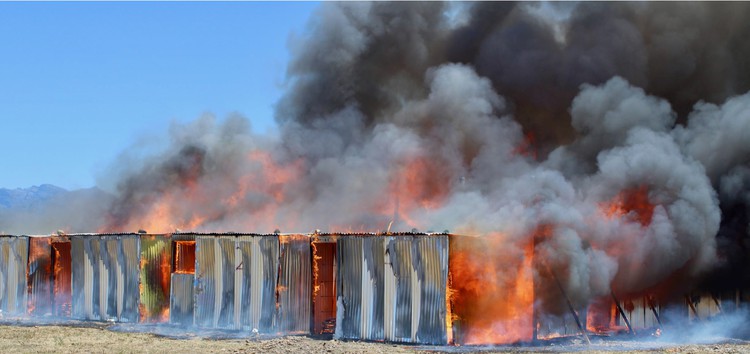20 shacks ignited in five minutes in experiment
University fire engineering research shows that fire-resistant paint does not work
An experiment by the Fire Engineering Research Unit at Stellenbosch University showed how 20 homes in an experimental informal settlement caught fire in five minutes. Photo: Stellenbosch University.
- In an experiment to see how quickly fires spread in informal settlements, 20 shacks ignited in five minutes.
- After 16 minutes hardly any homes were left standing.
- Temperatures of 1,200ºC were recorded.
- The Stellenbosch University experimenters conclude that fire-resistant paint and other “gimmicks” won’t help under such fire conditions.
An experiment by the Fire Engineering Research Unit at Stellenbosch University (FireSUN) has shown how rapidly fires can spread in informal settlements even under light wind conditions. Twenty shacks were ignited in five minutes.
Professor Richard Walls, who lead the experiment, said, “We knew fires spread fast in informal settlements, but we never expected it to be this fast. The wind speed was only 15-20 km/h and it pushed straight through all the homes … If a southeaster is blowing, the fire would spread even faster and it would be very difficult to contain.”
Temperatures of 1,000°C were reached within a minute.
“After around 16 minutes there were hardly any homes left standing. There was simply a pile of scrap metal lying on the ground. Temperatures of up to around 1,200°C were measured, and flames many meters high emerged from the dwellings.”
FireSUN and the Western Cape Disaster Management, Fire & Rescue Services and the Breede Valley Municipality Fire Department built the settlement on a training site of the department outside Worcester. The work forms part of a collaborative project with the University of Edinburgh and funded by Global Challenges Research Fund in the United Kingdom.
To simulate the correct environment a life-scale, mock informal settlement with 20 shacks was constructed in four rows of five homes. The walls of the homes were lined with cardboard. Timber and corrugated steel were also used. “It was important to use materials that are representative of what are found in homes, so we could analyse the behaviour of the fire”.
The dwellings were spaced 1.2 metres apart, except for four instances where the spacing was 2.2 metres. These distances are typical of dwelling spaces found in denser informal settlements. The fire was ignited at four dwellings on the left-hand side, to model a fire in a large settlement and it rapidly spread from left to right.
Walls said the experiment was designed to simulate a “fire line” which could be found in a dense settlement as a large fire moves through it. “We included extensive instrumentation, thermal-imaging cameras, a drone and other equipment in the experiment to provide data on flame lengths, temperatures experienced, spread rates and details regarding when homes ignited.”
A fire line is the fort position of the fire, where one would try to fight it. “Behind the fire line there is just rubble left.” He added that the wind, which is a massive problem in Cape Town often blows embers far away and start fires where people further away from the fire may think they are safe. Fire also burns faster uphill, due to the rising of hot gasses.”
“People often criticise the fire department for not acting swiftly enough, but our experiment showed that a fire can move really, really fast. Firefighters have always known this, but now we have better experimental data to understand the problem and analyse interventions,” he said.
Walls said it’s no secret that fire risk makes informal settlements extremely dangerous, “but we can show what does not work”.
“Fire-resistant paint would have had little impact due to the intensity of the fire and the fact that the fire ignited homes through any small openings in these structures, negating the influence of coatings. Doors and windows in a densely-packed settlement will always provide an easy entrance for fire. Gimmicks are often peddled to people such as balls and vials to throw at the fire – they don’t work and are expensive,” he said.
Walls said people often phone the wrong number when a fire breaks out which delays the correct fire and rescue station from reaching them. It is therefore important for local communities to build relationships with their local fire station. People can also be equipped to start putting out fires; help to clear the road access for the fire trucks; help to get low-laying cables out the way; and to look after the fire hydrants in their area.
Video World’s largest informal settlement fire experiment - 20 homes ignited in 5 minutes.
Support independent journalism
Donate using Payfast

Don't miss out on the latest news
We respect your privacy, and promise we won't spam you.
Next: Environmentalists raise concern over polluted Durban river
Previous: Neighbouring communities fight for jobs at construction project
© 2020 GroundUp. This article is licensed under a Creative Commons Attribution-NoDerivatives 4.0 International License.
You may republish this article, so long as you credit the authors and GroundUp, and do not change the text. Please include a link back to the original article.

